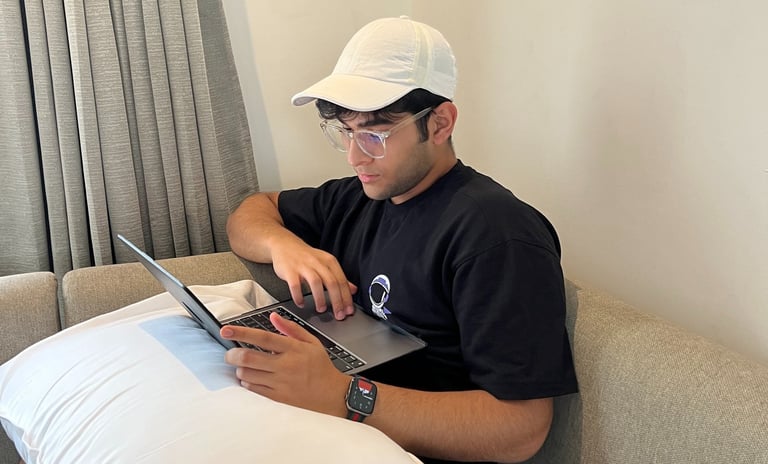Inside the Mind of a Young Creator: How I Stay Focused in a Noisy World
At just 17, I am balancing high school, running a profitable startup, managing Meta ads, writing a book, and staying consistent at the gym. In this blog, I share my personal playbook on how to stay focused, build digital discipline, and protect creative energy in a world full of noise and distraction.
Medhansh Seth
6/19/20253 min read


Inside the Mind of a Young Creator: How I Stay Focused in a Noisy World
We live in a world that screams for our attention — scrolls, swipes, notifications, and never-ending feeds. As someone who's 17, running a business, studying commerce in school, writing a book, managing ads, and squeezing in workouts at the gym—staying focused isn’t a choice anymore. It’s essential.
But it wasn’t always this way. I’ve had my share of burnout days, productivity slumps, and moments where I felt like I was doing everything but getting nowhere. Over time, I’ve learned that managing attention is more important than managing time.
Here’s how I do it—a behind-the-scenes look into how I protect my focus, build discipline, and keep showing up consistently.
🔌 1. Digital Discipline: Turning My Phone from a Distraction into a Tool
Let’s be honest—the phone is a productivity killer if not used with intent. My business, AceCubing.com, runs partially off Instagram and Meta ads, so I can't avoid my phone. But I can control how I use it.
Focus Mode & App Limits: I’ve set custom focus modes on my iPhone — one for school hours, one for work, and one for deep writing. Each mode hides irrelevant apps, blocks notifications, and keeps my attention narrow.
One-Touch Rule: Every time I unlock my phone, I ask, “Am I using this or just scrolling?” That awareness alone stops 90% of pointless use.
NO PHONE— I wish I had good willpower to not touch my phone, but whenever I am working, I just throw it on my bed to make sure that I have no way of touching it.
Digital minimalism doesn’t mean cutting out tech — it means being the master, not the slave.
🧩 2. Time Blocking & Weekly Planning
With school from 6:45 AM to 3:30 PM, gym in the evening, and tuitions on MWF, my time is limited — so I treat it like gold.
Google Calendar is my CEO. I plan each week on Sunday night, blocking time for gym, deep work, meetings, and content creation.
Color-coded blocks: School is red, business tasks are blue, content writing is yellow, and self-time is green. Visual structure reduces decision fatigue.
Weekly Review: Every Saturday, I look back: What worked? What flopped? What drained me? I fix what’s broken before burnout hits.
This system helps me avoid chaotic to-do lists. It turns “I’m busy” into “I’m in control.”
💻 3. Writing, Coding, and Working in Deep Focus Mode
When I write book chapters, build course content, or work on website updates, I go into what I call Deep Work Sprints. These are 60-90 minute sessions of uninterrupted, high-focus work.
Here’s my exact setup:
Phone on silent, flipped down.
Single tab open.
Lo-fi or instrumental music in the background (no lyrics).
Physical notebook nearby—I jot down random thoughts that try to distract me instead of acting on them.
I use the Pomodoro technique occasionally—50 minutes of work, 10 minutes of break. But more often, I just go with momentum. When you're in flow, nothing beats that state.
🏋️ 4. Gym and Physical Discipline
The gym is more than fitness for me — it’s mental training.
1 hour daily — sometimes right after school, sometimes at night after tuitions. I don’t negotiate with this.
It clears my head, recharges my mind, and teaches me the value of consistency.
It’s where I think clearly — a lot of my best ideas for AceCubing or my book come between sets.
Working out also reminds me: progress comes slowly, but it compounds if you just show up every day.
🧠 5. Mental Reset & Energy Check-Ins
Burnout isn’t caused by doing too much. It’s caused by doing too much of what doesn’t energize you.
So every few days, I ask myself:
What’s giving me energy right now?
What’s draining me?
Am I building, or just reacting?
If my calendar is full of reactive tasks — like fixing issues, replying to people, or checking stats — I know I need to carve out a “creation block” and make something. Whether it’s a cube tutorial, a blog post, or a new idea for an ad — creation resets me.
I also take offline breaks — like my recent trips to Jim Corbett and Dehradun — to come back with clearer perspective.
📈 6. Ad Management and Switching Mental Modes
Running ads for AceCubing.com requires a different headspace than writing or coding. It’s analytical — but also creative.
I handle this by batching ad-related work. I don’t jump between editing a caption and fixing a Shopify bug. I schedule ad reviews, creative edits, and analytics deep-dives in one go — usually on weekends or late nights.
And when it’s time to switch modes — say, from “ad manager” to “student” — I take a 15-minute walk, change my desk setup, or just listen to a new playlist. Small rituals make big shifts.
🚀 Final Thoughts: Focus is a Skill You Build
I’m still learning. Still refining. Still messing up some days.
But what I know for sure is this — focus isn’t a gift. It’s a practice. You build it like you build a muscle. Every time you resist the scroll, say no to a distraction, or commit to a block of deep work — you get sharper.
And in a noisy world, that sharpness is your advantage.

